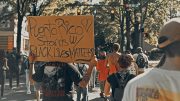By: Nicole Lashomb*/TRT Editor-in-Chief—
This February, we celebrate Black History Month, honoring the many contributions the black community has made to America. Often, it is accompanied by a plethora of facts to enlighten others of such contributions. Students may learn the famous words of Martin Luther King’s “I Have a Dream” speech or study George Washington Carver’s research, which lead to promotion of alternative crops such as cotton, peanuts, soybeans and sweet potatoes, or study other African-American inventors. And for others of us, we mustn’t forget about the black gay adviser to Martin Luther King Jr., Bayard Rustin. This African American gay hero, born ahead of his time, set the stage for human rights at a time when as he spoke of equality, many disregarded him because he was black and gay. And, like the months honoring the history of other marginalized communities, those teachers and their students are likely to move on to the next one, usually only paying homage during those 28 days in February, in this case.
While these facts are indisputably significant for the country to learn about, especially since much of black history has perished due to racism and extremism of the “majority,” it isn’t solely about the few lessons we are taught during these mere 28 days. But, somehow, many Americans take comfort in thinking that they have done all is possible to educate themselves on Black History and on our country’s tainted past, a past that still wreaks havoc today.[pullquote]”… We also do this by celebrating the nameless faces and experiences that make our community so diverse, resilient, and unique. With only 28 days dedicated to this endeavor, Black History Month is ultimately about instilling ongoing values of pride, empowerment, appreciation, and education not just for the month of February but every day, every month, all year long.” —Corey Yarbrough, Executive Director, Hispanic Black Gay Coalition, Boston, Mass. [/pullquote]
The question I posit is not about the usual facts that are often regurgitated year after year to honor and learn about black history. However, it is about how we can bring to life the experiences of the African American community from the past and into the present. In addition to learning the facts, we should also address issues like racism and discrimination and honestly discuss how it has transformed from the past and morphed into today. We should especially discuss the impact that racism has within our LGBT community. Through personal journeys and narratives, black history will not become solely the facts of the past, but a life-altering experience in the present.
I will continue to seek the truth in others’ experiences and learn from them about racially and ethnically marginalized groups. Since I cannot speak from personal experience, I can be the best ally possible and attempt to bring awareness to these issues. I urge others who hold societal privilege to do the same and get involved in local community organizations that play a crucial role for the black/LGBT community. Corey Yarbrough, Executive Director of the Hispanic Black Gay Coalition, sums up what black history means to him.
“For me, Black History Month is a time to intentionally affirm the beauty, perseverance and brilliance of African Americans and all people of African descent while educating new generations on the momentous contributions of Black people across various fields, professions, and geographic locations. We do this by honoring past figures, many who have been erased or excluded from modern history books and discussions. We also do this by celebrating the nameless faces and experiences that make our community so diverse, resilient, and unique. With only 28 days dedicated to this endeavor, Black History Month is ultimately about instilling ongoing values of pride, empowerment, appreciation, and education not just for the month of February but every day, every month, all year long.”
* The author is the Editor-in-Chief and Co-Founder of The Rainbow Times, holds an MBA from Marylhurst University and a Bachelor’s from SUNY Potsdam, NY. You can reach Ms. Lashomb at editor@therainbowtimesmass.com.







